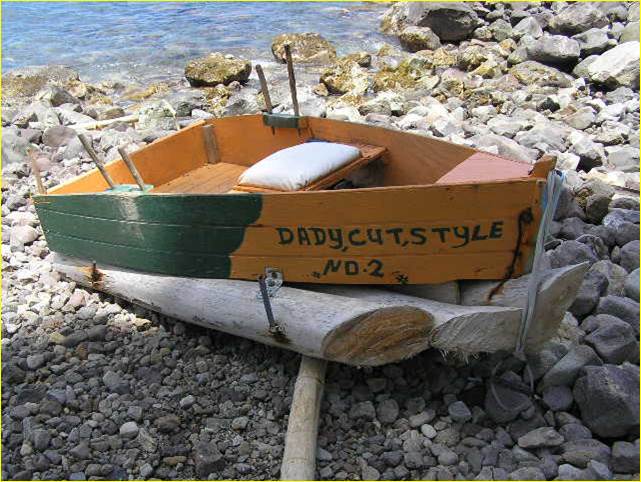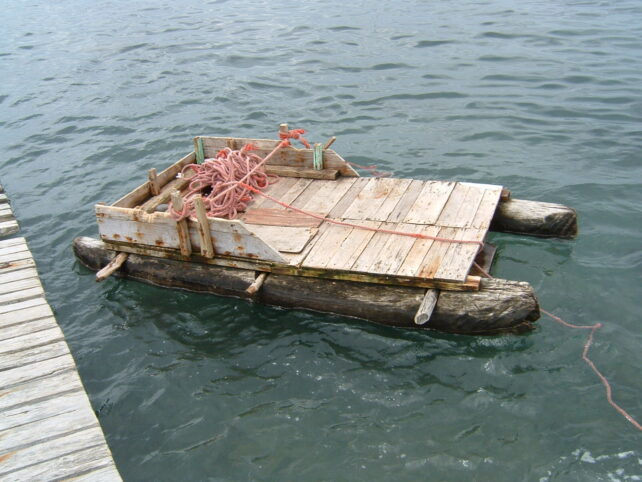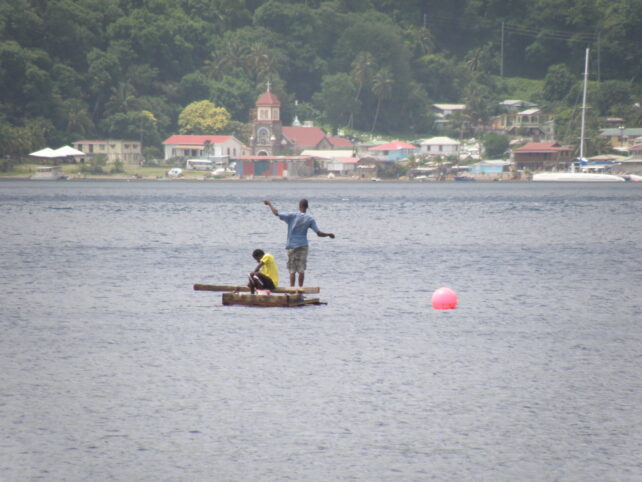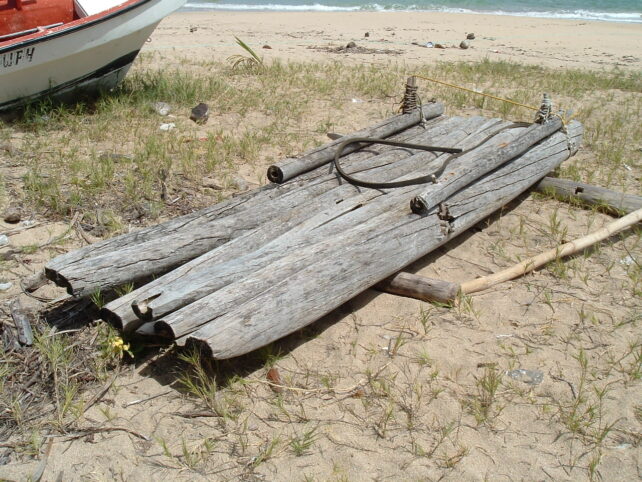
Several methods of sea fishing are employed on Dominica. These include the setting of baited fish pots (‘nas latjé’ and ‘nas dòmi’ in Kwéyòl), casting of ‘lépouvyé’ hand nets near shore, setting of seins, use of FADs (fish attracting devices) far offshore, line fishing off rocks, from the shore, and from fiberglass boats, dugout canoes or other small fishing crafts – including fishing rafts.
Dominica’s Kwéyòl word for fishing raft is ‘PWIPWI’ which originated from the Kalinago word ‘piperie’, although the Kwéyòl word is also used quite often in ‘Dominican Kwéyòl-English’, e.g. “My cousin build a new pwipwi last week.”
The word pwipwi may sound foreign to some Dominicans, depending firstly on the person’s age, and secondly on which part of the country the person comes from as this type of fishing craft is associated primarily with coastal communities. Some readers may be surprised to know that the pwipwi is not known in St. Lucia which, at one time, Dominicans referred to as our “Sister Island”.
Now, if one were to conduct a pwipwi ‘survey’ among coastal communities on the island, it would be observed that there are variations in the design of the raft according to the region. So, let’s get out our pair of ‘wanm’ (oars), jump on board a pwipwi and cruise around the coast looking at the diversity in Dominica’s pwipwis.
PWIPWI ‘STYLE & FASHION’: The main parts of a pwipwi are the logs or ‘runners’ – placed parallel to each other and which allow the craft to float; the floor (called the ‘planché’ in Kwéyòl) which is made from pieces of board or plywood; and the sides (called the ‘bòdaj’ in Kwéyòl). However, not every pwipwi is constructed with a floor and/or sides.

The pwipwis built by fisherfolk in the North-East of the island comprise as many as eight (8) pieces of small logs from the ‘Bwa Flo’ or Balsa (Ochroma pyramidale) tree. Amazing, one may say! Those logs would be considerably smaller than those utilized for rafts on the leeward side of the island, in areas such as Pottersville, Pointe Michel, Colihaut, Loubiere, Soufriere, Scott’s Head, Clifton, in the North e.g. Penville, and in the South-East, e.g. at La Plaine. Further, the logs are not of uniform length and their leading ends are not shaped into a V-like bow of a catamaran as is the case with leeward coast rafts. North-Eastern pwipwis, e.g. from Woodford Hill, Mon Bati Beach at Anse Soldat and possibly other areas also have no floor or siding (See photo above).
Devon Greenaway from the northern village of Clifton disclosed that when pwipwis were made in his area, a piece of galvanized roofing material would sometimes be nailed underneath the raft. This was to prevent excess sea water from getting through the spaces between the logs and excessively wetting the occupant(s) of the raft as those pwipwis had no flooring. The writer recalls seeing a Bwa Flo pwipwi on Soufriere Beach some years ago with its floor covered with a piece of black-and-white linoleum (a.k.a. ‘kapit’).

And, talk of more diversity! Lazare Charles, former Chaiman of the Layou Improvement Committee related that in addition to using Bwa Flo logs for the ‘runners’, pwipwis in Layou were also made from two other raw materials: bamboo and the pseudostem (locally called the ‘stem’) of the banana plant. The banana pseudostem is called ‘baton-fig’ and ‘kò-fig’ in our Kwéyòl and the latter name translates into English to literally mean ‘the body of the banana plant’.
In the case of the bamboo pwipwi, the pieces of bamboo stem, which would be carefully selected, would be cut all to the same length and arranged parallel to each other, very tightly, in three layers of several pieces each, depending on how wide the builders wanted their pwipwi. The entire raft would be held together using long strips of bark (‘cord’) from the ‘Maho Piman’ (Daphnopsis americana ssp. caribaea) tree, and there was no planché (flooring) or sides.
Meanwhile, pwipwis made from the second alternative material used by the Layou folks, i.e. lengths of the banana pseudostem are reported to be quite heavy. Two ‘layers’, each of 3 to 4 pieces of pseudostem, tightly arranged, would be held together by small Glory Cedar poles, or poles cut from a tree known in the Layou-St. Joseph area as ‘Danndakayou’. The kò-fig or baton-fig pwipwi, like the bamboo version, would have no flooring or sides.
Interestingly, Julian Pacquette, well-known Youth Officer from Grand Bay, disclosed that as a young boy growing up in Grand Bay, he and his peers would use two or three cut lengths of driftwood collected off the stony beach at Grand Bay to make their pwipwi which would be fitted with a floor made from “pieces of board”.
However, possibly the fanciest and most sophisticated pwipwi that the writer came across during casual observations made over the years was one on Clifton Beach, around 2007. That one had five pieces of Bwa Flo logs for the base and was shaped like a small fishing boat that Dominicans call a ‘chaloup’; the floor and inner sides were painted yellow; the sides were made of decorative plywood and the outer part painted green (rear half) and golden-yellow; it had a raised cushioned seat; and it was named, “Dady, Cut, Style No. 2” which was hand-painted in green against the yellow background! (See opening photo).
GENERAL USES OF PWIPWI: The main use of the pwipwi on Dominica is to facilitate near-shore line fishing out at sea. Youths and adult men were the users.

However, according to Lazare Charles, when fishing rafts were commonly used by villagers of Layou in the past, these were utilized mostly by young boys from the village to facilitate line-fishing in the Layou River – Dominica’s largest and longest river. He noted that the youngsters would fish for ‘bwoché, ‘dòmé’ ‘kawang’ that moved up from the sea, ‘koko’, ‘mèy’ (silver mullet), ‘pag’, and even the freshwater eel that Dominicans call ‘zanji’. Youths from St. Joseph also used pwipwis on the Layou River.
OTHER TRADITIONAL USES OF PWIPWI: Lazare also disclosed that pwipwis built in Layou were also used by the youngsters from the village to take casual rides up Layou River, especially during school vacations. And, importantly, they were used by the adults to transport agricultural and other produce from up-river areas down to the village. Such produce included coconut shell charcoal, wood charcoal, bananas and other agricultural produce grown on the farms in upstream areas.
Over in the North-East, Ms Anelta Abraham of Woodford Hill disclosed that many years ago, persons from Woodford Hill would use pwipwis – made from Bwa Flo or Bwa Kanno (Cecropia peltata) logs – to go fishing on Pan Lake which is located in the village and is larger than Boiling Lake. She noted further that young children from the village would also sometimes use the rafts to take casual, recreational rides on this man-made lake which is 475 ft long, about 250 ft wide and 13ft deep.
REMARKS: This article was meant to share with readers the variations in the building designs of and the materials used for building fishing rafts on Dominica, as well as the uses of these traditional fishing craft.
The building and use of pwipwis is part of Dominica’s rich cultural heritage. But today, we see fiberglass boats rapidly replacing our dugout canoes and pwipwis in some coastal fishing communities. However, in areas such as Pointe Michel, Soufriere, Scott’s Head and other areas in the west, south-east, south-west and north-east e.g. Woodford Hill pwipwis are still very much in use. So, the next time that you pass through or near one of our fishing communities and you see a pwipwi, stop and take a closer look. You may just get a surprise!

Special Thanks to Mrs Anelta Abraham, Messers Cecil Carbon, Lazare Charles, Francisco ‘Tinko” Esprit, Devon Greenaway, Dr. Lennox Honychurch, Julian Pacquette, Percy Pierre, and Donald Anthony and Junior Matthrine in St. Lucia for sharing information about pwipwis in their particular communities.
All photos by the author.

Very interesting and informative article. Hoping to see more like this 😎👍🏽👌🏽
interesting love this , there might be a little more pwi pwi versions around Dominica –
Remind me of the.calypso – I forgot the calypsonians name with the words “if I had a chance to stay with Mama or on Dominica, I’ll take it on a pwi pwi to Africa, anywhere but here” the happenings now among the upper level party members. Very sad.